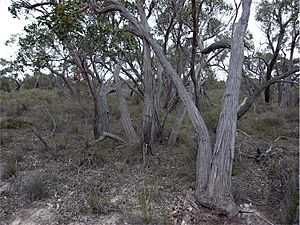Desert stringybark facts for kids
Quick facts for kids Desert stringybark |
|
|---|---|
 |
|
| Eucalyptus arenacea in the Little Desert National Park | |
| Scientific classification | |
| Genus: |
Eucalyptus
|
| Species: |
arenacea
|
The Desert Stringybark (scientific name: Eucalyptus arenacea) is a special kind of tree or large shrub. It's also called the Sand Stringybark. You can only find it in south-eastern Australia, which means it's endemic there. This plant has rough bark that covers even its smallest branches. Its grown-up leaves are shaped like a spear or are a bit curved. Its flower buds look like clubs and grow in groups of seven to fifteen. When they bloom, the flowers are white, and the fruit is round or half-round.
Contents
What Does the Desert Stringybark Look Like?
The Desert Stringybark is usually a tree with many stems, or it can be a strong mallee. A mallee is a type of eucalyptus that grows multiple stems from a large, woody base underground called a lignotuber. This plant can grow to be about 3 to 10 meters (10 to 33 feet) tall.
Its Bark and Leaves
It has rough, stringy bark that covers its trunk and even its thinnest branches. Young plants and new shoots that grow after a fire (called coppice regrowth) have leaves that are arranged in pairs. These young leaves are egg-shaped, about 35 to 85 millimeters (1.4 to 3.3 inches) long and 30 to 40 millimeters (1.2 to 1.6 inches) wide.
The adult leaves are shiny green and grow one after another along the stem. They are shaped like a spear or are slightly curved. These leaves are about 70 to 120 millimeters (2.8 to 4.7 inches) long and 15 to 40 millimeters (0.6 to 1.6 inches) wide. Each leaf has a stalk called a petiole, which is about 10 to 25 millimeters (0.4 to 1.0 inches) long.
Flowers and Fruit
The flowers grow in groups of seven to fifteen. They appear in the axils of the leaves, which are the spots where a leaf joins the stem. Each group of flowers grows on a main stalk called a peduncle, which is about 5 to 18 millimeters (0.2 to 0.7 inches) long. Each individual flower bud sits on a smaller stalk called a pedicel, about 2 to 5 millimeters (0.08 to 0.2 inches) long.
The mature flower buds are oval or club-shaped, about 5 to 6 millimeters (0.20 to 0.24 inches) long and 3 to 5 millimeters (0.12 to 0.20 inches) wide. They have a rounded or cone-shaped cap called an operculum. The Desert Stringybark mainly blooms in December and January, and its flowers are white.
After flowering, the plant produces fruit. The fruit is shaped like a hemisphere (half a sphere) or a slightly flattened sphere. It is about 4 to 9 millimeters (0.16 to 0.35 inches) long and 7 to 12 millimeters (0.28 to 0.47 inches) wide. Each fruit also sits on a short pedicel, up to 3 millimeters (0.12 inches) long.
How Was it Named?
The scientific name Eucalyptus arenacea was officially described in 1988. It was named by two scientists, Julie Marginson and Pauline Ladiges. Their description was published in a scientific journal called Australian Systematic Botany.
The second part of the name, arenacea, is a Latin word. It means "of sand," which makes sense because this plant often grows in sandy areas.
Where Does the Desert Stringybark Live?
The Desert Stringybark grows in sandy places. You can find it on pale-colored sandhills and flat sandy areas. These areas are located between towns like Keith, Pinaroo, and Bordertown in a region called the Ninety Mile Desert in South Australia. It also grows in the Little Desert and Big Desert areas of Victoria.



